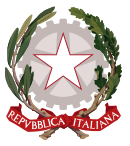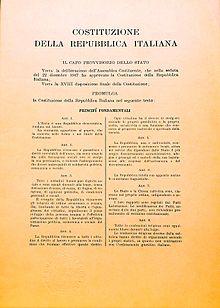- Constitution of Italy
-
Italy 
This article is part of the series:
Politics and government of
ItalyConstitution- Constitution
- Gazzetta Ufficiale
Executive- President (List)
- Prime Minister (List)
Judiciary- Constitutional Court
- Court of Cassation
- Court of Assizes
- Italian Council of State
- Italian Criminal Procedure
- Judiciary of Italy
Divisions- Regions
- Politics of Aosta Valley
- Politics of Piedmont
- Politics of Lombardy
- Politics of Veneto
- Politics of Trentino-Alto Adige/Südtirol
- Politics of Friuli-Venezia Giulia
- Politics of Emilia-Romagna
- Politics of Liguria
- Politics of Tuscany
- Politics of Umbria
- Politics of Marche
- Politics of Molise
- Politics of Lazio
- Politics of Abruzzo
- Politics of Campania
- Politics of Apulia
- Politics of Calabria
- Politics of Sicily
- Politics of Sardinia
- Provinces
- Municipalities
ElectionsForeign policy
The Constitution of the Italian Republic (Italian: Costituzione della Repubblica italiana) was enacted by the Constituent Assembly on 22 December 1947, with 453 votes in favour and 62 against. The text, which has since been amended 13 times, was promulgated in the extraordinary edition of Gazzetta Ufficiale No. 298 on 27 December 1947. The Constituent Assembly was elected by universal suffrage on 2 June 1946, at the same time as a referendum on the abolition of the monarchy. The Constitution came into force on 1 January 1948, one century after the Statuto Albertino had been enacted.[1] Although the latter remained in force after Benito Mussolini's March on Rome in 1922, it had become devoid of substantive value.
Contents
Context
The forces that enlivened debate in the Assembly fell into three groups, Christian democratic, liberal and left-wing. Because all were deeply anti-fascist, there was general agreement against an authoritarian constitution.[2]
If you want to go on a pilgrimage to the place where our Constitution was created go to the mountains where partisans fell, to the prisons where they were incarcerated and to the fields where they were hanged. Wherever an Italian died to redeem freedom and dignity, go there young people and ponder: because that was where our Constitution was born. — Piero Calamandrei[3]However, each group was concerned about its success in new elections after the promulgation of the Constitution, and fought to insert provisions reflecting their values; the result was that some aspects of the text (for example, concerning marriage and the family) refer to Roman Catholic-oriented natural law themes, whilst others (for example, concerning workers' rights) are more reminiscent of socialist and communist thinking. This has been repeatedly described as the constitutional compromise,[4] and the parties representing the three ideologies that shaped the Constitution were referred to as part of the arco costituzionale (literally, "constitutional arch").
Provisions
 The provisional head of state, Enrico De Nicola, signing the Constitution by virtue of disposition XVIII.
The provisional head of state, Enrico De Nicola, signing the Constitution by virtue of disposition XVIII.
The Constitution is composed of 139 articles (four of which were later abrogated) and arranged into three main parts: Principi Fondamentali, the Fundamental Principles (articles 1–12); Part I concerning the Diritti e Doveri dei Cittadini, or Rights and Duties of Citizens (articles 13–54); and Part II the Ordinamento della Repubblica, or Organisation of the Republic (articles 55–139); followed by 18 Disposizioni transitorie e finali, the Transitory and Final Provisions.
Articles 13–28 are the Italian equivalent of a bill of rights in common law jurisdictions. Power is divided among the executive, the legislative and judicial branches; the Constitution establishes the balancing and interaction of these branches, rather than their rigid separation.[5]
Whilst Article 8 establishes the liberty of all religions before the law, Article 7 recognises the special status given to the Catholic Church by the Lateran Treaty in 1929. That status was modified by a new agreement between church and state in 1984.[6]
The Constitution previously forbade the male descendants of the former royal family, the House of Savoy, from entering the territory of the Republic; however, this provision was repealed in 2002.[7][8]
It is important to note that the Constitution primarily contains general principles; it is not possible to apply them directly. As with many written constitutions, only few articles are considered to be self-executing. The majority require enabling legislation, referred to as accomplishment of constitution.[9] This process has taken decades and some contend that, due to various political considerations, it is still not complete.
Amendments
 One of three original copies, now in the custody of Historical Archives of the President of the Republic.
One of three original copies, now in the custody of Historical Archives of the President of the Republic.
In order to make it virtually impossible to replace with a dictatorial regime, it is difficult to modify the Constitution; to do so (under Article 138) requires two readings in each House of Parliament and, if the second of these are carried with a simple majority (i.e. 50%+1) rather than two-thirds, a referendum. Under Article 139, the republican form of government cannot be reviewed. When the Constituent Assembly drafted the Constitution, it made a deliberate choice in attributing to it a supra-legislative force, so that ordinary legislation could neither amend nor derogate from it.[10] Legislative acts of parliament in conflict with the Constitution are subsequently annulled by the Constitutional Court.
Three Parliamentary Commissions have been convened in 1983–1985, 1992–1994 and 1997–1998 respectively, with the task of preparing major revisions to the 1948 text (in particular Part II), but in each instance the necessary political consensus for change was lacking.[11]
The text of the Constitution has been amended 14 times. Amendments have affected articles 48 (postal voting), 51 (women's participation), 56, 57 and 60 (composition and length of term of the Chamber of Deputies and Senate of the Republic); 68 (indemnity and immunity of members of Parliament); 79 (amnesties and pardons); 88 (dissolution of the Houses of Parliament); 96 (impeachment); 114 to 132 (Regions, Provinces and Municipalities in its entirety); 134 and 135 (composition and length of term of the Constitutional Court). In 1967 articles 10 and 26 were integrated by a constitutional provision which established that their last paragraphs (which forbid the extradition of a foreigner for political offences) do not apply in case of crimes of genocide.
Four amendments were passed during the thirteenth legislature (1996–2001), these concerned parliamentary representation of Italians living abroad; the devolution of powers to the Regions; the direct election of Regional Presidents; and guarantees of fair trials in courts.[12] A constitutional law and one amendment were also passed in the fourteenth legislature (2001–2006), namely, the repealing of disposition XIII insofar as it limited the civil rights of the male descendants of the House of Savoy;[13] and a new provision intended to encourage women's participation in politics. Further amendments are being debated, but for the time being 61.32% of those voting in the 25–26 June 2006 referendum rejected a major Reform Bill approved by both Houses on 17 November 2005 and the attempt to revise Part II appears to have been abandoned or at least postponed indefinitely after almost 25 years.[14][15] Nonetheless, in 2007, the constitution was amended making capital punishment illegal in all cases (before this the Constitution prohibited the death penalty except "in the cases provided for by military laws in case of war;" however, no one had been sentenced to death since 1947 and the penalty was abolished from military law in 1994).[16]
See also
- Birth of the Italian Republic
- Treaty of Peace with Italy, 1947
- Treaty establishing a Constitution for Europe
- Rule according to higher law
References
- ^ Einaudi, Mario The Constitution of the Italian Republic The American Political Science Review vol. 42 no. 4 (pp. 661-676), August 1948
- ^ Clark, Martin Modern Italy: 1871 to the Present 3rd ed. (p. 384) Pearson Longman, Harlow: 2008
- ^ Speech to the young held at the Humane Society Milan, 26 January 1955
- ^ Smyth, Howard McGaw Italy: From Fascism to the Republic (1943–1946) The Western Political Quarterly vol. 1 no. 3 (pp. 205-222), September 1948
- ^ Tesauro, Alfonso The Fundamentals of the New Italian Constitution (trans. Ginevra Capocelli) The Canadian Journal of Economics and Political Science / Revue canadienne d'Economique et de Science politique volume 20 no. 1 (pp. 44-58), February 1954
- ^ Agreement Between the Italian Republic and the Holy See reproduced in International Legal Materials vol. 24 no. 6 (p. 1589) The American Society of International Law, November 1985
- ^ Vittorio Emanuele di Savoia: "Fedeltà alla Costituzione" La Repubblica, 3 febbraio 2002
- ^ Willan, Philip Exiled Italian royals go home The Guardian, 24 December 2002
- ^ Adams, John Clarke and Barile, Paolo The Implementation of the Italian Constitution The American Political Science Review volume 47 no. 1 (pp. 61-83), March 1953
- ^ How the Court Was Born What is the Constitutional Court? (p. 9) The Italian Constitutional Court (retrieved 28 October 2007)
- ^ Pasquino, Gianfranco Reforming the Italian constitution Journal of Modern Italian Studies volume 3 no. 1, Spring 1998
- ^ De Franciscis, Maria Elisabetta Constitutional Revisions in Italy, the Amending Process in Janni, Paolo (ed.) Italy in Transition: the Long Road from the First to the Second Republic The 1997 Edmund D. Pellegrino Lectures on Contemporary Italian Politics, Cultural Heritage and Contemporary Change, Series IV: West Europe and North America vol. 1 The Council for Research in Values and Philosophy, 1998
- ^ Legge costituzionale per la cessazione degli effetti dei commi primo e secondo della XIII disposizione transitoria e finale della Costituzione LEGGE COSTITUZIONALE 23 ottobre 2002, n. 1 (GU 252 del 26 ottobre 2002)
- ^ Italy Senate passes reform bill BBC News, 16 November 2005 19:24 GMT
- ^ Italy resoundingly rejects reform BBC News, 26 June 2005 19:27 BST
- ^ Promotion by Council of Europe member states of an international moratorium on the death penalty Council of Europe, Parliamentary Assembly, Resolution 1560 (2007), 26 June 2007
External links
- La Costituzione della Repubblica Italiana Senato della Repubblica (Italian)
- The Constitution of the Italian Republic Senate of the Republic (English)
- Guide to Italian Legal Research and Resources on the Web
- The Constitution of the Italian Republic - Audiobook (Italian)
Constitutions of Europe Sovereign
states- Albania
- Andorra
- Armenia
- Austria
- Azerbaijan
- Belarus
- Belgium
- Bosnia and Herzegovina
- Bulgaria
- Croatia
- Cyprus
- Czech Republic
- Denmark
- Estonia
- Finland
- France
- Georgia
- Germany
- Greece
- Hungary
- Iceland
- Ireland
- Italy
- Kazakhstan
- Latvia
- Liechtenstein
- Lithuania
- Luxembourg
- Macedonia
- Malta
- Moldova
- Monaco
- Montenegro
- Netherlands
- Norway
- Poland
- Portugal
- Romania
- Russia
- San Marino
- Serbia
- Slovakia
- Slovenia
- Spain
- Sweden
- Switzerland
- Turkey
- Ukraine
- United Kingdom
- Vatican City
States with limited
recognition- Abkhazia
- Kosovo
- Nagorno-Karabakh
- Northern Cyprus
- South Ossetia
- Transnistria
Dependencies
and other territoriesOther entities - European Union
- Sovereign Military Order of Malta
Categories:- Government of Italy
- Italian law
- Constitutions by country
Wikimedia Foundation. 2010.
